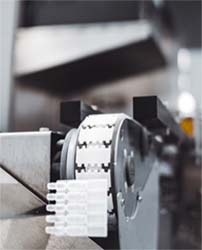Effectively managing temperature of the drug product throughout the Blow-Fill-Seal process is vital to a successful fill and finish process.
This graph will show what temperature changes a drug product will experience during the BFS process.
The graph is taken from a 0.5mL fill run by ApiJect, but it is purely illustrative as actual temperature changes will depend on a number of variables including the drug product, fill size, BFS machine, and other important factors.
Leading up to the moment of filling, the drug product is kept at a cold temperature in a mixing vessel. From this vessel, drug product is transferred through sterilizing filters into an intermediate holding tank or ‘buffer tank’.
From this holding tank, the drug product is transferred into the filling system or “filling mandrel” where it’s stopped until it’s needed to fill the container.
In a simultaneous process, the pharmaceutical-grade resin is heated to a molten state in the BFS machine and formed by an actively cooled mold.
As the container is formed, it immediately begins to cool. As this cooling continues, the drug product begins to fill the just-formed container.
The initial drug product that enters the plastic container will quickly spike in temperature. However, the temperature of both the drug product and container rapidly cool as the rest of the drug product is filled.
The entire filling process happens in approximately one second.
Over the next several seconds, the container’s opening is sealed, the mold is opened, and the container is released. During this time, the temperature continues to decrease. Eventually, it reaches an equilibrium with the surrounding environment.
There are several ways BFS manufacturers have effectively managed drug product temperatures throughout this process.
ApiJect has worked with its partners to develop various modifications to the BFS process and equipment to address particularly challenging temperature issues. We would be happy to discuss this with any partner who views temperature as a concern for their drug product.
